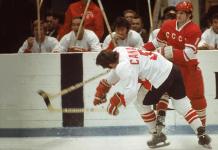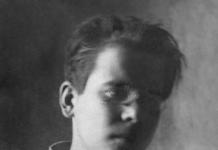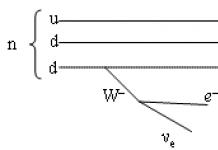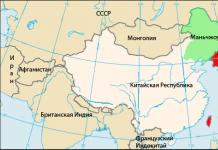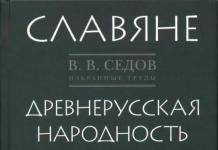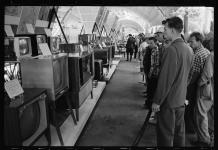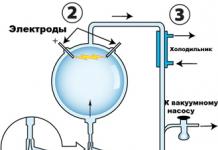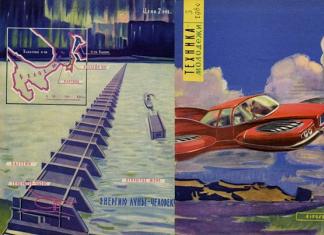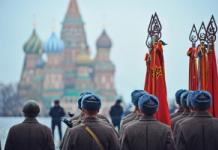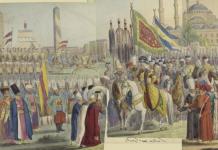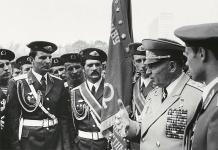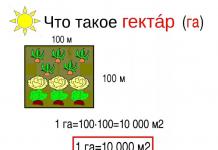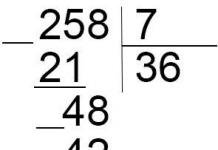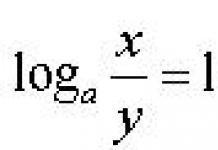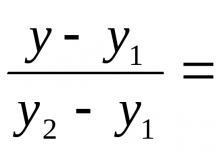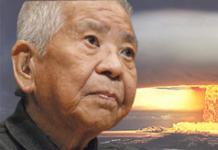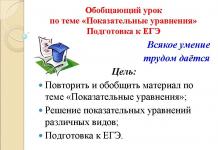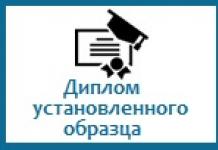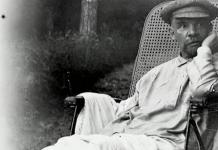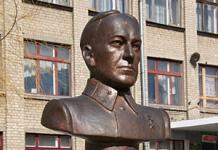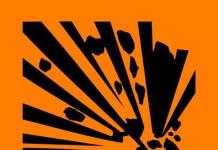Ivan Mikhailovich Sechenov
Outstanding physiologist.
Born on August 1, 1829 in the village of Teply Stan, Simbirsk province, in the family of a retired Russian officer who once served in the famous Preobrazhensky regiment, created by Peter I. There were Kalmyks in the Sechenov family (by mother).
Sechenov recalled:
“Of all my brothers, I became my mother’s black relatives.
I was a very ugly boy, black, curled up and badly disfigured by smallpox (my parents must not have had time to inoculate me with smallpox, she attacked me in my first year and disfigured me one of the whole family), but he must have been smart, very cheerful and possessed the art of imitating gaits and voices, which often amused his family and friends. There were no peers in years, boys, neither in the families of acquaintances, nor in the courtyard; I grew up all my life between women, so I had neither boyish habits, nor contempt for the female sex; besides, I was trained in the rules of courtesy. On all these grounds, I enjoyed the love of my family and the benevolence of my acquaintances, not excluding the ladies and young ladies. "
In 1839, after the death of his father, Sechenov, on the advice of his older brother, an officer, entered the Main Engineering School in St. Petersburg, where they took the lowest tuition fees. “Whoever had money,” Sechenov recalled, “could during these hours (lunch break) buy at their own expense (in the canteen from servant Galkin) rolls with butter and green cheese and sweet pies, and for the poor, a large basket with slices was displayed in the canteen black bread. Many of us, the poor, in the winter, when the stoves were heated, turned these slices into crackers. Stove pipes served as drying rooms, and by evening the delicacy was ready to crunch on the teeth. "
Sechenov studied at the same time as the future writers Dostoevsky and Grigorovich.
Chemistry and physics, which were well taught at the school, undoubtedly helped Sechenov to define his interests. “They taught mathematics well,” he recalled. - In the lowest class - arithmetic; in the next - algebra, geometry and trigonometry; in the second grade - analytical geometry and descriptive; at the top box office - differential calculus and analytical mechanics. Integral calculus was led by the famous mathematician Ostrogradskiy, who jokingly assessed the mathematical abilities of his listeners very low. The highest score - 12 - he gave the first mathematician - God, then - the great Euler; he gave himself 9 points; differential calculus teacher - 6 points, and all students - zero. Mathematics was given to me, and if I got from the Engineering School to the university at the Faculty of Physics and Mathematics, I could have left a decent physicist, but fate decided otherwise ”.
In 1848 Sechenov graduated from college and was assigned to serve in a sapper battalion near Kiev. Receiving an officer's rank was a holiday. “There have been many joyful moments in my life, but of course there was no such joyful day as this one. You stop being a schoolboy, you roll out into the wild, there are no more prohibitions, live as you want, and even with money in your empty pocket. One thing upset me a little - there was still no mustache, but I did not fail to help this grief - in the very first days I bought invoices and in the evenings sported them on the streets. "
“If our society had not woken up in general to a new ebullient activity,” K. A. Timiryazev wrote later with a great deal of justice, “maybe Mendeleev and Tsenkovsky would pass their days in Simferopol and Yaroslavl, the lawyer Kovalevsky would be a prosecutor, cadet Beketov - a squadron commander, and the sapper Sechenov would have dug trenches according to all the rules of his art. "
In Kiev, Sechenov did a lot of self-education, he was drawn to medicine. In 1850, having achieved his release from service, he moved to Moscow and entered the medical faculty of Moscow University. Leading scientists - professors K.F.Rul'e, I. T. Glebov, F. I. Inozemtsev taught at the Faculty of Medicine. In the clinic of Professor Inozemtsev, Sechenov completed his first scientific work. There he also dealt with issues of psychology, which interested him extremely. Sechenov's friendship with the doctor S.P. Botkin contributed a lot to this.
In general, Sechenov's Moscow circle of acquaintances turned out to be extremely wide. He constantly met with N. G. Chernyshevsky, D. I. Mendeleev, I. I. Mechnikov, K. A. Timiryazev, V. I. Vernadsky, S. P. Botkin, A. M. Butlerov, F. M. Dostoevsky, M. A. Balakirev, A. P. Borodin, artist A. A. Ivanov. One of his acquaintances - with the doctor P.I.Bokov, who was a member of some radical and revolutionary circles of those years, turned out to be very important for Sechenov. Bokova's friend Maria Alexandrovna, daughter of General Obruchev, entered into a fictitious marriage with Bokov in order to get a higher education. This marriage turned into an actual one, but soon Bokova became a close friend, and then Sechenov's wife.
“I called Maria Alexandrovna my benefactress, and not for nothing,” Sechenov recalled at the end of his life. - I entered her house as a young man, who until then had been floating inert along the channel into which fate had thrown me, without a clear consciousness where she could lead me. And I left her house with a ready-made life plan, knowing where to go and what to do. Who, if not she, brought me out of a situation that could become a dead loop for me, indicating the possibility of a way out. To what, if not her suggestions, I owe the fact that I went to the university - and precisely to the one that she considered the most advanced - to study medicine and help my neighbor. It is possible, finally, that a certain amount of her influence was also reflected in my further service to the interests of women who are making their way on an independent path. "
The famous work of Sechenov "Reflexes of the Brain" and the equally famous novel by Chernyshevsky "What is to be done?" came out in one year. Contemporaries easily guessed the prototypes of the heroes of the novel. In Lopukhov, they agreed to see the doctor Bokov, in Vera Pavlovna - Maria Alexandrovna, in Kirsanov - Sechenov. So, the famous dreams of Vera Pavlovna, especially her very first dream, in which it is about going and helping all the suffering and prisoners, were not at all a romantic invention, but the general mood that pervaded the society of that time.
In 1856, after graduating from Moscow University, Sechenov, using part of the inheritance received after the death of his mother, left for Germany. In Berlin, he studied comparative anatomy with I. Müller, physiology with E. Dubois-Reymond, and histology with E. Hoppe-Seiler. In Vienna, Sechenov worked for the famous Karl Ludwig. There he prepared a thesis "Materials for the future physiology of alcohol intoxication", which he defended in 1860 at the Medical-Surgical Academy in St. Petersburg. In the process of work, Sechenov independently designed a device called an absorptiometer. This device, designed to study gases dissolved in blood, later served as a model for others, more advanced, built later by European scientists.
In 1860, Sechenov was elected professor of the St. Petersburg Medical-Surgical Academy in the Department of Physiology. Sechenov's lectures have always been carefully thought out. They attracted not only students, but everyone who was interested in modern science. One of Sechenov's listeners later recalled: “He always said to his closest students: 'Work, work with all your might! Do not waste your dear young years on unproductive labor and entertainment! Remember that you get a higher education - this color of thought - for the last pennies of a Russian disadvantaged peasant and that you are an unpaid debtor to him. Try to be a useful worker in life and fulfill your civic duty by seriously preparing for your upcoming activity. "
At the same time, Sechenov's candidacy was proposed for the vacant post of adjunct in physiology at the Academy of Sciences. However, Sechenov personally withdrew his candidacy. Later, in his Autobiographical Notes, he frankly wrote: “I had no reason to think that I would be worthy of such a high honor, but I didn’t want to live with red ears and therefore flatly refused.”
In 1861 Sechenov published "Two final lectures on the significance of the so-called plant acts in animal life." In this work, he expressed deep ideas about the unity of organisms and the conditions of their life, especially emphasizing the extremely important importance of experimental physiology. The published lectures ended with the following words: “... You probably have ever heard or read that an organism means a body that contains within itself the conditions for existence in the form in which it exists. This thought is false and harmful, because it leads to huge mistakes. An organism is impossible without an external environment that supports its existence, therefore, the scientific definition of an organism must also include the environment that influences it. Since the existence of an organism is impossible without the latter, the debate about what is more important in life - whether the environment or the body itself, does not make the slightest sense. "
In the autumn of 1862, Sechenov spent in Paris in the laboratory of K. Bernard.
“He was not such a teacher as the Germans,” Sechenov wrote, “and he always worked out the themes that arose in his head with his own hands, without leaving, so to speak, his office. That is why it was impossible for someone who came to him for a short time, like me, to learn anything in the laboratory. " Nevertheless, it was in the laboratory of Professor K. Bernard that Sechenov made a discovery that immortalized his name. Carrying out experiments on frogs, he discovered in their brain the presence of special mechanisms that suppress or inhibit reflexes - the response motor reactions of a living organism to stimulation received from outside. Sechenov opened the brain and the upper part of the spinal cord in the frog, and then made transverse incisions in the area of the so-called visual hillocks. Hanging the frog prepared in this way by the jaw, he immersed its hind limbs in a bath with sulfuric acid solution and kept track of the clock (or with the help of a metronome) how long it would take until the frog pulled the paw away from the solution. This is how Sechenov determined the speed of the reflex response to stimulation.
From the experiments done, he deduced curious patterns.
It turned out, for example, that when a crystal of sodium chloride in the brain of a frog was irritated in the region of the visual hillocks, the time required for the frog to pull the paw away from the acid solution increased. But when the same crystal was applied to cross-sections in other parts of the brain, this did not in any way affect the timing of the reflex. Observation led Sechenov to the idea that there are centers in the frog's brain that can inhibit the reflex activity of the spinal cord.
Sechenov called his discovery central inhibition.
Trying to figure out the meaning of the discovery for man, Sechenov set up some of the experiments on himself. It is known that a person, unlike animals, can delay some reflexes by purely volitional means. Touching the sulfuric acid solution with his fingers and suppressing the instantly arising desire to withdraw his hand, Sechenov received confirmation of his guesses. It became clear to him that by force of will it is really possible to influence the speed of muscle contractions, even the contraction of the heart muscle.
In 1863, a psycho-physiological treatise "Reflexes of the Brain" appeared in the journal "Medical Bulletin".
Initially, this work of Sechenov was intended by the author for the journal Sovremennik, edited by N.A. obligatory name change.
However, the censorship's hope that the article would not be noticed in a special journal did not come true. The issues of the magazine were passed from hand to hand, Sechenov's terminology entered everyday language. In 1866, when Sechenov's work was published as a separate book with a circulation of 3,000 copies, it was immediately seized as having an "undeniably harmful direction". The motives of the censors were as follows:
“Sechenov's work explains the mental activity of the brain. It is reduced to a single muscular movement, which always has an external, material action as its initial source. Thus, all the facts of a person's mental life are explained in a purely mechanical way. This materialistic theory, which brings a person, even the most exalted, into a state of a simple machine devoid of any self-consciousness and free will, acting fatalistically, subverts all concepts of moral obligations, of the sanity of crimes, takes away all merit and all responsibility from our actions; destroying the moral foundations of society in earthly life, thereby destroying the religious dogma of the future life, it does not agree with either the Christian or the criminal-legal view and leads positively to the corruption of morals. " They say that when Sechenov was asked which of the experienced lawyers he would involve in his defense, Sechenov replied: “Why do I need lawyers? I'll just take a frog with me and do my experiments in front of the judges. " For almost a year, the case passed from the office to the office. Only the government's reluctance to advertise the book to criminal proceedings even more did not give the case a move and the book went on sale.
Sechenov's work made a huge impression on his contemporaries.
As a natural scientist, he first penetrated into the dark until that time and, for various reasons, always attractive for any person, the field of mental phenomena. He found the courage to assert that all acts of a person's conscious and unconscious life by the mode of origin are just reflexes. From this very position it followed that, since reflexes are impossible without an initial impulse from the outside, then the mental life of a person is supported and stimulated by the influences that the sense organs receive either from external or internal stimuli.
In addition, the readers saw in the book not just a physiological treatise. Familiar with the famous novel by Chernyshevsky, they seemed to be waiting for the appearance of "new" people. The formation of a strong-willed personality was associated in their minds with the moral regulation of actions. According to Sechenov (and this was close to the readers), in the development of such regulation, the main role should have been played by a person's collision with life, that is, education, in the broadest sense of the word.
Keep your hand over the fire and don't pull it back!
Always be able to demonstrate your inner strength!
After all, upbringing accordingly determines the work of the brain mechanisms themselves, both inhibiting the motor reaction and strengthening it.
Continuing his work, Sechenov took up an in-depth study of Western psychological literature. True, soon enough he discovered with great disappointment that "... a person studying psychology has nothing to look at the German transcendentalists, that is, in Kant, Fichte, Schelling and Hegel." While in Germany, he wrote to Bokova: “... Since I ordered all the philosophical books from the local bookstore, the other day they sent me such the latest rubbish that I, trying to read, did not understand a word positively. And this, as it turns out, is still engaged in the darkness of the Germans. Frankly, I will not be in the spirit to study German metaphysics. " And further (in a letter dated November 4, 1867): “... Concerning psychology, I have the following plan in my head. The main representatives of the Herbart school live in Leipzig; I will have to be there in any case (for the sake of meeting with Ludwig), and therefore I had the following idea: to turn to these gentlemen, that, they say, you want physiologists to take part in the development of psychology - I am a physiologist and with such intentions , then, would you like to have a systematic debate about fundamental questions of psychology during my stay in Leipzig? If this thought came true, it would be extremely useful for me. "
Such a discussion did take place.
But not in Germany, but in Russia.
The reason for the discussion was the extensive work of the professor of law at St. Petersburg University KD Kavelin "Tasks of Psychology", published in the journal "Vestnik Evropy" in early 1872. The name of Sechenov was not named in Kavelin's article, but since the article dealt with the doctrine of reflexes, the readers perfectly understood who the pathos of the author was directed against, who was proving the originality of mental life, the ability to evoke thoughts in pure arbitrariness. The author argued that one of the main tasks of psychology is the collection of experimental data on the psyche, and the products of human creative activity can serve as the most objective material for its study.
In the article "To Whom and How to Develop Psychology," published in the same journal, Sechenov sharply objected to Kavelin. He invited him “... to make the following experiment on himself: say, for one hour, at least, for example, 200 different nouns (of course, such cases must be excluded from the experience, such as, for example, whole associations of various words memorized from childhood, like exceptions to the Latin grammar, a number of numbers, conjugation of different verbs, etc.). In doing so, I take the liberty of predicting the following result, Sechenov wrote. - If, before the experiment, Mr. Kavelin thought, for example, about psychology in general, then his first words would be approximately: psychology, soul, body, idealism, Kant, Hegel, etc., and it is very possible that he will succeed in the experiment; but if, under the same conditions, it was possible to demand from him by chance that he spoke the nouns known to him, relating, for example, to cooking, gardening, etc., then the matter would go much more difficult, despite the fact that in these cases ready-made associations, expressed, for example, in the fact that after cabbage it is already very easy to say carrots, potatoes, etc. But let us assume that the result would be successful in this case too. Then let Mr. Kavelin try to say, for example, two words each from psychology, from kitchen art, gardening, etc. Here the result will probably already be negative, despite the fact that before each section of nouns there is a generic concept that embraces dozens of species representations in associations ".
“Man is a definite unit in the series of phenomena represented by our planet,” Sechenov wrote, “and his whole, even spiritual life, as far as it can be the subject of scientific research, is an earthly phenomenon. Mentally, we can separate our body and our spiritual life from everything around us, just as we mentally separate color, shape or size from the whole object, but does this separation correspond to real separation? Obviously not, because that would mean to tear a person away from all the conditions of his earthly existence. "
Sechenov considered the main issue of the problem of sensations to be the question of "coordination of movements with feeling." In 1878, in his work "Elements of Thought", he first explored the role of movements and motor sensations in the processes of perception and thinking, showing their importance in the analysis and measurement of space and time. It was this work that gave IP Pavlov a basis to declare at one of the international physiological congresses: “I am convinced that an important stage of human thought is approaching, when the physiological and psychological, objective and subjective will really merge, when the painful contradiction is actually resolved or disappears in a simple natural way. or the opposition of my consciousness to my body. "
Sechenov made important discoveries.
For example, he was the first to discover and describe the role of muscles as sensory organs ("dark muscular feeling"), discovered and described periodic rhythmic bioelectric phenomena in the central nervous system, gave an experimental substantiation of the doctrine of blood gases and their exchange during breathing, and also came to conclusions about the laws governing the dissolution of gases in solutions of various salts, which was a major contribution to the physical chemistry of solutions. The work of Sechenov (and also his student N. Ye. Vvedensky) in the field of peripheral nerve physiology is of great importance. Having studied the reasons for the death of French aeronautics flying in the Zenith balloon, Sechenov for the first time gave correct calculations and indicated physiological ways to fight against impaired tissue respiration in humans during high-altitude flights.
In 1870, Sechenov was forced to leave the Medico-Surgical Academy. One of the reasons for this decision was the official refusal of the Academy Council to elect the remarkable Russian scientist II Mechnikov to the free department of zoology. Chemist N.N. Zinin tried to help Sechenov move to the Academy of Sciences, but the doors of the Academy were closed for the liberal-minded scientist. For some time he worked in the laboratory of his old friend DI Mendeleev. “It is possible that I will become a chemist, but, of course, these are dreams,” he wrote with bitterness in one of his letters. In the end, Sechenov got a position as professor of physiology at Novorossiysk University in Odessa.
Only in 1876 he returned to St. Petersburg.
Here Sechenov created the first Russian physiological school. Among his students were such outstanding scientists as N. Ye. Vvedensky and N. P. Kravkov. Nevertheless, in 1888, after the Academy of Sciences rejected his candidacy for the third time, Sechenov decided to retire. He left the university department at Vvedensky, in spite of that. that by this time there were fundamental scientific disagreements between teacher and student. At the same time, Sechenov finally officially married Bokova. “Everyone considered the resignation 'quite unexpected'. - wrote M. I. Yanovskaya, - and the reason was simple: Ivan Mikhailovich started life anew. At sixty, he first tasted formal marriage. A family that should not be hidden from anyone's eyes, a wife who since then began to smile as she never smiled ... "
Sechenov idolized his wife.
“In work, she was not just a comrade,” he recalled, “but also an example. In her estate there was a horse called Komar, which was distinguished by the fact that in harness, without any adulation, as if out of a sense of assumed responsibility, she always kept the lines taut, and in case of need she pulled with all her might, even tired, often working for others. This was the image of Maria Alexandrovna in all her occupations - in translations, in matters of rural economy. As Komar conducted his affairs honestly, so did Maria Alexandrovna; her translations did not require outside editing; she could not stand tears in anything, not in her dress, not in the household, not in life; as soon as they appeared, she tried not to let them grow into a hole and immediately began to repair ... There were times in her life where sealing gaps, which usually occurred through no fault of her, required long and painful efforts on her part ... a pure devoted worker, she thought little about the external embellishments of life for herself. But she loved, as far as the funds allowed, to deliver them to those of the loved ones whom they pleased. Behind this appearance of an active, intelligent and educated worker stood a woman who knew how to control herself, with a warm heart, capable of active good. For her loved ones, she was a constantly caring nanny - this was almost the main trait in the heart of her nature. However, she looked at her loved ones with open eyes and most of all did not tolerate lies and falsehood. Thus, in her nature there were all the conditions to give a loved one, who knows how to distinguish gold from tinsel, happiness in youth, in adulthood and in old age. "
Sechenov spent a year at his estate Teply Stan, then, at the insistence of his friends, took the modest position of assistant professor at Moscow University. Perhaps then he was the most famous assistant professor in the world. The German physiologist Ludwig offered Sechenov to move to Germany and work in his personal laboratory, but Sechenov refused.
Only in 1891 he was elected professor.
In 1901, Sechenov published the well-known course "Essay on the Workers' Movements of Man", laying the foundation for the study of issues of the physiology of labor. At the same time he prepared the second edition of the work "Elements of thought" and published a new work "On the question of the influence of sensory stimuli on the muscular work of a person."
Assessing Sechenov's contribution to physiology, Pavlov wrote:
“Yes, I am glad that together with Ivan Mikhailovich and the regiment of my dear collaborators, we acquired the entire inseparable animal organism for the mighty power of physiological research instead of half-heartedly. And this is entirely our Russian indisputable merit in world science, in general human thought. "
A short man who loved black coats, outwardly not distinguished by anything special, Sechenov invariably attracted people to him. “In Teply Stan, Ivan Mikhailovich usually was in a very good mood,” one of his students wrote about him. “He made visits to neighbors and played cards, always a penniless game. He knew how to talk well with poorly educated village women, without any effort keeping himself in the circle of their domestic, garden and kitchen interests. However, if educated ladies tried to occupy him, according to his rank, with serious and even learned conversations, one could notice sparks of laughter in his shining eyes. "
the authorIvan Mikhailovich Sechenov Outstanding physiologist. Born on August 1, 1829 in the village of Teply Stan, Simbirsk province in the family of a retired Russian officer who served in his time in the famous Preobrazhensky regiment, created by Peter I. In the Sechenov family (by mother) were
From the book The most famous scientists of Russia the author Prashkevich Gennady MartovichIvan Mikhailovich Gubkin Geologist was born on September 9, 1871 in the village of Pozdnyakovo, Vladimir province, into a peasant family. Illiterate parents could not give their son education. He learned to read and write thanks to his grandmother, who sent him to a rural school. This allowed Gubkin
From the book Great Soviet Encyclopedia (CHI) of the author TSB From the book of 100 famous Muscovites the author Sklyarenko Valentina MarkovnaSechenov Ivan Mikhailovich (born in 1829 - died in 1905) An outstanding scientist, whose name entered the annals of world science. Naturalist, founder of the Russian physiological school - "the father of Russian physiology", as he was called, the creator of the natural science direction in
From the book Big Dictionary of Quotes and Expressions the author Dushenko Konstantin VasilievichGRONSKY, Ivan Mikhailovich (1894–1985), publicist, Soviet literary figure 1005 The main method of Soviet literature is the method of socialist realism. Speech at a meeting of the activists of literary circles in Moscow on May 20, 1932? "Lit. newspaper ", May 23, 1932 At the beginning of May
From the book The Newest Philosophical Dictionary the author Gritsanov Alexander AlekseevichSECHENOV Ivan Mikhailovich (1829-1905) - Russian physiologist and psychologist. Honorary Member of the St. Petersburg Academy of Sciences (1904). Major works: "To whom and how to develop psychology" (1873), "Elements of thought" (1878), "Subject thought and reality" (1892), "Impressions and reality" (1890),
(1829-1905) - a great Russian scientist, the founder of the Russian physiological school and materialistic psychology in Russia, corresponding member. (1869) and honorary member (1904) of the Petersburg Academy of Sciences.
In 1848 he graduated from the Main Engineering School in St. Petersburg and was sent to serve in a sapper battalion near Kiev. In 1851 he resigned and entered the medical department. Faculty of Moscow University. After graduating from un-that in 1856 he was sent abroad to prepare for a professorship, worked in the largest laboratories under the leadership of I. Müller, E. Dubois-Reymond, K. Ludwig, K. Bernard and others. return to his homeland defended by doct. dissertation "Materials for the future physiology of alcoholic intoxication" and was elected professor of the Department of Physiology of the St. Petersburg Medical-Surgical Academy. During his work, the department of the Academy became a center for the propagation of materialistic ideas in biology and medicine. Since 1870, I. M. Sechenov is a professor at the Department of Physiology at Novorossiysk University in Odessa, and since 1876, Professor at the Department of Physiology at the Physics and Mathematics Department of St. Petersburg University. In 1889, I.M.Sechenov began to work for honey. Faculty of Moscow University in the position of assistant professor of the Department of Physiology, and in 1891 he became its professor and head. In 1901, IM Sechenov gave up the head of the department in order, in his words, "to clear the way for the young forces." Until the end of his life, I.M.Sechenov continued to work in the laboratory at the department, created and equipped by him at his own expense.
I.M.Sechenov belongs to that galaxy of Russian scientists of the 19th century, to-rykh distinguished by an amazing versatility of talent and scientific interests. N. G. Chernyshevsky, I. T. Glebov, F. I. Inozemtsev, K. F. Rule played an important role in the formation of the materialist worldview of I. M. Sechenov. The name of I. M. Sechenov is associated with the development of many questions in various fields of physiology, which are of great practical and theoretical importance. He is responsible for research on the physiology of respiration and blood, the dissolution of gases in liquids, gas exchange and energy exchange, alcohol poisoning, the physiology of c. n. With. and neuromuscular physiology, electrophysiology. Oya is the creator of new directions in fiziol. science, he laid the foundations of materialistic psychology.
A significant part of the experimental research of I.M.Sechenov is devoted to the study of the regularities of the distribution of gases in the blood, in particular, the dissolution, binding and transportation of carbon dioxide. With the help of a device designed by him - an absorptiometer, which made it possible to analyze with great accuracy the absorption of gases by whole blood and plasma, he made a fundamentally new conclusion for that time that erythrocytes in blood play an extremely important role in the exchange of CO2. Having studied the absorption of CO2 by various salt solutions, he established an empirical formula reflecting the relationship between the solubility of gases in the electrolyte and the concentration of the latter. This formula is known in science as the formula, or equation, Sechenov.
Studying the features of gas exchange between blood and tissues and between the body and the environment, I.M.Sechenov showed that the process of binding oxygen by hekhmoglobin favors the easier release of carbon dioxide from the blood. Investigation of the causes of death of two French astronauts who ascended the Zenith balloon to an altitude of 8600 m ,? led him to the formulation of the theory of the constancy of the gas composition of alveolar air (1882) as the most important condition for the normal existence of the organism. These studies subsequently contributed to the development of a new direction in Russian physiology - aviation and space physiology.
Work on the study of gases in the blood is associated with studies of gas exchange in the body, to-rye were carried out by I. M. Sechenov together with M. N. Shaternikov. This served as the beginning for the study of energy costs in humans for various types of physical and mental labor. For this purpose, they built a portable gas analyzer, which made it possible to carry out long-term studies of gas exchange in a person who is both at rest and in motion.
Of particular scientific significance are the works of I.M.Sechenov in the field of neurophysiology, closely related to his psychological and philosophical quest aimed at creating a holistic view of the body and its connections with the environment. I. M. Sechenov belongs to the opening of central inhibition (see). a cut brought him worldwide fame and entered the science iodine by the name of Sechenov's inhibition (see). He was the first to describe two other fundamental phenomena in c. n. S. - the sum of excitations and aftereffect. The continuation of these works was research in the field of electrophysiol. brain stem activity. He was the first (1882) to discover and describe the rhythmic potentials of the medulla oblongata. It was the first research in the world, at Krom electrophysiol. the method was applied to analyze the activity of c. n. With.
In subsequent years, the scientific interests of I.M.Sechenov were focused on the study of patterns and fiziol. features of human labor activity, fiziol. the basics of the regime of work and rest. His article "Physiological Criteria for Setting the Length of the Working Day" (1895) was in fact the first special study in the world literature devoted to the scientific substantiation of the extremely topical and politically important issue of the length of the working day of workers. These studies formed the basis of a new branch of physiology - the physiology of labor.
I.M.Sechenov is rightfully considered the founder of domestic materialistic physiology in. n. and psychology. He for the first time, using strictly scientific methods, began the study of complex phenomena in the activity of the brain, opposed the existing idealistic views on the processes of mental activity. He not only considered mental activity to be a function of the brain, but also consistently defended the position that this activity was determined by the conditions of existence. According to the scientist, mental phenomena "are subject to the same immutable laws as the phenomena of the material world, because only under this condition is it possible to truly scientific development of mental acts."
I. M. Sechenov, who convincingly proved that "all acts of conscious and unconscious life by the mode of origin are reflexes", for the analysis of behavior both in the physiology of the nervous system and in psychology, he chose a reflex, which is a natural and deterministic reaction of the organism to the action of the environment. environment (see Reflex, Reflex theory). A new step made by I.M.Sechenov in the history of materialistic psychology consists in the fact that he considered the mental component as an integral part of the reflex of the brain, as a necessary link in that category of reflexes, which he called reflexes with mental complications. The objective method of studying mental phenomena developed by I.M.Sechenov was developed in the works of V.M.Bekhterev, I.P. Pavlov and received worldwide recognition. I.M.Sechenov's idea of the reflex basis of mental activity was the foundation for the construction of psychophysiology, it contributed to the creation and development of physiology in. n. etc.
The works of I.M.Sechenov on the study of various branches of physiology were aimed at understanding the integral activity of the organism in the unity of its bodily and mental manifestations, in its inextricable connection with the material world. In his research, I.M.Sechenov proceeded from the basic principle of materialistic natural science - the unity of the organism and the environment. “An organism is impossible without an external environment that supports its existence,” he wrote, “therefore, the scientific definition of an organism must also include the environment that influences it. Since the existence of an organism is impossible without the latter, disputes about what is more important in life, whether the environment, or the body itself, do not have the slightest meaning. "
The idea of the unity of the organism and the environment, the strict causality of all manifestations of mental activity, was most fully developed in the work of I. M. Sechenov "Reflexes of the Brain" (1863), called by I. P. Pavlov "the genius wave of Russian scientific thought." In this work, I. M. Sechenov for the first time establishes an inextricable link between the physiological and the mental and develops the idea of "transferring mental phenomena, from the side of the way they are performed, onto physiological ground," thereby emphasizing that the "mental" activity of a person is subject to the same laws , as bodily, and can be studied using fiziol. methods.
I. M. Sechenov laid the foundations for the evolutionary interpretation of physiological functions. According to I. M. Sechenov, the driving forces of evolution are "the influence on organisms of the environment in which they live, or more precisely, the conditions of their existence," to which they must adapt. It is they who act as a powerful factor of variability, the transformation of simple forms into complex ones, the generation of new biological forms and processes. The peculiarity of Sechenov's evolutionary biological approach is that it extended to the highest level of organization - the nervous system. His teaching embodied the inextricable link between natural science and materialism. Therefore, behind him, in principle far from direct active participation in political events, the reputation of a "notorious materialist, who tries to carry out materialism not only in science, but also in life itself" has been established.
I.M.Sechenov's activities largely contributed to the development of domestic scientific medicine. His theoretical works and views had a tremendous influence on the formation of the advanced ideas of Russian doctors. They contributed to the development of fiziol. directions in psychiatry, neurology, therapy, etc.
In the life and work of I.M.Sechenov, the features of a great scientist and thinker and an outstanding teacher, educator of creative youth were harmoniously combined. He strove to introduce the principles of experimental physiology and the materialistic worldview into the practice of teaching physiology to university students. He is honored to create the first physiological school in Russia. Such talented scientists as B. F. Verigo, H. E. Vvedensky. V. V. Pashutin, N. P. Kravkov, G. V. Khlopin, I. R. Tarkhanov, M. N. Shaternikov, A. F. Samoilov were his students.
I. M. Sechenov was a brilliant popularizer of natural scientific knowledge among the general population. This is evidenced by his numerous public lectures, lectures to workers at the Prechistensky courses, as well as translations and editing of scientific and popular scientific books. He was an ardent supporter of women's medical education (see). In the laboratories he created, he attracted women to active scientific work. Under his leadership, for the first time, Russian female doctors N.P.Suslova and M.A. dissertation.
I.M.Sechenov was an honorary member of many scientific societies in Russia, was elected honorary chairman of the first international psychological congress in Paris (1889). The versatile scientific and social activities of I.M.Sechenov left a deep mark in many areas of physiology, his theoretical views and research had a tremendous impact on the formation of the materialistic views of Russian doctors and physiologists. I.M.Sechenov's ideas found worldwide recognition and largely determined the future development of Soviet physiology and psychology. The 1st MMI is named after I.M.Sechenov.
Compositions: Materials for the future physiology of alcoholic intoxication, die., St. Petersburg, 1860; Autobiographical notes, M., 1907, 1952; Collected works, v. 1-2, M., 1907-1908; Selected Works, M., 1935; Selected works, v. 1-2, M., 1952-1956; Lectures on physiology, M., 1974.
Bibliography: Anokhin P.K.From Descartes to Pavlov, p. 70, M., 1945; Artemov H. M. Ivan Mikhailovich Sechenov, 1829-1905, Bibliography. index, L., 1979; Vvedensky H.E. Ivan Mikhailovich Sechenov, Proceedings of S.-Peterburgsk. Society of Naturalists, vol. 36, c. 2, p. 1, 1906; Ivan Mikhailovich Sechenov (To the 150th anniversary of his birth), ed. P. G. Kostyuk and others, M., 1980; To and - ganov V. M. Worldview of I. M. Sechenov, M., 1948; Koshtoyants X. S., I. M. Sechenov, M., 1950; Kuzmin MK, Makarov VA and And in and to and V. P. N., IM Sechenov and medical science, M., 1979; Sechenov I.M. and materialistic psychology, ed. S. L. Rubinstein, M., 1957; Sha-ternikov MN Ivan Mikhailovich Sechenov, Scientific Word, no. 10, p. 23, 1905; Yaroshevsky M.G. Sechenov and world psychological thought, M., 1981.
V. A. Makarov.
, humanist, educator, philosopher and rationalist thinker, creator of the physiological school; Honored Ordinary Professor, Corresponding Member of Biological Discharge (-), Honorary Member () of the Imperial Academy of Sciences. Chevalier of the Orders of St. Stanislaus I degree, St. Anna III degree, St. Vladimir Equal to the Apostles III degree.
Merit
Transformed physiology into an exact science and clinical discipline used for diagnosis, choice of therapy, prognosis, development of any new methods of treatment and drugs, protection of a person from dangerous and harmful factors, exclusion of any experiments on white people in medicine, public life, all branches of science and the national economy. In his classic work "Reflexes of the Brain" (1866), written for the journal Sovremennik, N.A. , which can be studied by objective methods, and which are determined by the interaction of cells, organisms and populations with the external (the basic biological law of Rul'e-Sechenov) and the internal environment. Censorship throughout the life of the scientist forbade the publication of the main conclusion of this work: "Only with the view I developed on human actions in the latter is the highest of human virtues possible - all-forgiving love, that is, complete descent to one's neighbor." Free will is manifested by the purposeful change by each individual person of his external and internal environment. The task of society is not to prevent a person from becoming a knight in this way. If modern physics, chemistry, mathematics cannot help humanity in this and / or explain the phenomena studied by psychology, physiology and biology, then physiologists themselves must create the necessary physical and chemical theories or set appropriate tasks for chemists and physicists. Having acted as a defender of the traditions of classical medical education "on the side of the" ancient "(physicians-philosophers of antiquity) against the" new "" ("The Battle of the Books", Jonathan Swift) as an opponent of R. Virchow and supporters of his concept of "cellular pathology", for the first time in the world he formulated the doctrine of the anatomical and molecular principles of physiology, in the presentation of which, recognizing the decisive importance in normal physiology, which is the highest stage in the development of the anatomical principle of the cellular principle of R. Virchow, emphasized the importance of the molecular principle as the only possible general principle of (clinical) pathophysiology, since, in particular, differentiation of cells, the formation of organs and tissues, the exchange of signals between organs, tissues, individual cells are carried out in the environment of biological fluids, and usually pathological processes are interconnected with a change in the chemical composition of these biological fluids. Rejecting the previously dominant doctrine of a comprehensive system of inhibitory nerves, he proved its absence and substantiated the theory of transmission of inhibition signals by changing the chemical composition of biological fluids, especially blood plasma. He investigated renal blood circulation, digestion, gas exchange in the lungs, respiratory function of blood, discovered the role of carboxyhemoglobin in respiration and in the venous system. He discovered the phenomena of lens fluorescence, central inhibition, summation in the nervous system, "Sechenov's reflex", established the presence of rhythmic bioelectric processes in the central nervous system, substantiated the importance of metabolic processes in the implementation of excitation. For the first time in the world he localized the center of inhibition in the brain (thalamic center of inhibition, Sechenov center), discovered the influence of the reticular formation of the brain on spinal reflexes. Together with his wife, he was the first to translate into Russian the composition of Charles Darwin "The Descent of Man and Sexual Selection" and was the largest popularizer of evolutionary doctrine in Russia. Creator of an objective theory of behavior, founder of modern molecular physiology, clinical pathophysiology, clinical laboratory diagnostics, psychophysiology, narcology, hematology, neuroendocrinology, neuroimmunology, molecular medicine and biology, proteomics, bioelementology, medical biophysics, medical cybernetics, aviation labor, space medicine, physiology age, comparative and evolutionary physiology and biochemistry. The herald ("uncle", as he called himself) of Russian cosmism, the synthetic theory of evolution and the creation of modern cellular technologies for the formation of artificial organs and the restoration of organs. Scientifically substantiated the need for active rest ("Sechenov effect") and the duration of the working day is no more than six, maximum eight hours. In addition, he established the law of the solubility of gases in aqueous solutions of electrolytes. "... Physiology must recognize its undeniable father in the highly talented and equally original and bright personality of Ivan Mikhailovich Sechenov," wrote the physiologist and historian of science K. A. Timiryazev. “… Not a single Russian scientist had such a broad and beneficial influence on Russian science and the development of the scientific spirit in our society…” Ivan Petrovich Pavlov also considered Sechenov “the father of Russian physiology”. In November, Joseph Stalin named Sechenov among those who personify the spirit of the people, and for whom “brothers and sisters” should fight. Sechenov's works influenced the development of psychology, medicine, biology, natural science, oil and gas production, the gas transportation industry, the theory of knowledge, human rights, women's, workers' and trade union movements.
Biography
Abroad, Sechenov not only dispelled the notions that existed even among the best German scientists about the “inability of the round-headed Russian race” to understand modern physiology, but also prepared his doctoral dissertation “Materials for the future physiology of alcohol intoxication,” one of the first in Russian, which he successfully defended. in 1860 at the Medical-Surgical Academy in St. Petersburg, where by that time he had been transferred by vice-president I. T. Glebov. In the same year, at the invitation of I. T. Glebov, he began to work at the Department of Physiology of this Academy, where he soon organized a physiological laboratory - one of the first in Russia. For the course of lectures "On Animal Electricity" that amazed his contemporaries at the Medical-Surgical Academy - even such people far from medicine as I. S. Turgenev and N. G. Chernyshevsky attended it - he was awarded the Demidov Prize of the St. Petersburg Academy of Sciences. At the beginning of 1862 he took part in the work of the Free University, then worked in Paris in the laboratory of the "father of endocrinology" Claude Bernard, this leave was possibly connected with the arrests among the people of his circle on the cases of the proclamations "Great Russia" and ". In his classic work "Physiology of the Nervous System" in 1866, he formulated in detail his doctrine of self-regulation and feedbacks, further developed by the theory of automatic control and cybernetics, Sechenov investigated the same problems during a year's leave in 1867 - officially regarding the treatment of skin allergies , possibly related to the appeal to the Senate of the academician of the Medical-Surgical Academy Isidor with a request to exile Sechenov "for humility and correction" to the Solovetsky Monastery "for a prejudicial soul-destroying and harmful teaching." He spent most of this vacation in Graz, in the laboratory of his Viennese friend, physiologist and histologist, Professor Alexander Rollet (1834-1903). While working at the Academy, he took part in the organization of a scientific research marine biological station in Sevastopol (now).
Sechenov translated a lot, edited translations of books by foreign scientists in the field of physiology, physics, medicinal chemistry, biology, history of science, pathology, and he radically revised works on physiology and pathology and supplemented the results of his own research. For example, in 1867 Ivan Mikhailovich's manual "Physiology of the Senses" was published. Alteration of the composition "Anatomie und Physiologie der Sinnesorgane" von A. Fick. 1862-1864. Sight ", and in -1872, under his editorship in Russia, a translation of Charles Darwin's work" The Descent of Man "was published. The merit of I.M.Sechenov is not only the spread of Darwinism in Russia, where, for example, A.N. Beketov came to evolutionary ideas independently of Wallace and Darwin, but also the synthesis of physicochemical and evolutionary theories that he carried out for the first time in the world and the application of ideas Darwinism to the problems of physiology and psychology. IM Sechenov can rightfully be considered the predecessor of the modern development of evolutionary physiology and evolutionary biochemistry in Russia.
The name of Sechenov is associated with the creation of the first all-Russian physiological scientific school, which was formed and developed at the Medical-Surgical Academy, Novorossiysk, Petersburg and Moscow universities. At the Medical-Surgical Academy, independently of the Kazan School, Ivan Mikhailovich introduced the method of demonstrating an experiment into lecture practice. This contributed to the emergence of a close connection between the pedagogical process and research work and largely predetermined the success of Sechenov on the path of creating his own scientific school.
The physiological laboratory organized by the scientist at the Medical-Surgical Academy was the center of research in the field of not only physiology, but also pharmacology, toxicology and clinical medicine.
Brain research. Central braking
Back in the "Theses" for his doctoral dissertation, Sechenov put forward a proposition about the originality of reflexes, the centers of which lie in the brain, and a number of ideas that contributed to the subsequent study of the brain.
The experiments were demonstrated by Sechenov to Bernard, in Berlin and Vienna to Dubois-Reymond, Ludwig and E. Brücke. The thalamic center of inhibition of the reflex reaction was called the "Sechenov center", and the phenomenon of central inhibition - the Sechenov inhibition. An article in which Sechenov described the phenomenon of central inhibition appeared in print in 1866. According to the testimony of Charles Sherrington (), from that moment on, the assumption of the inhibitory effect of one part of the nervous system on another, expressed by Hippocrates, became an accepted doctrine.
In the same year, Sechenov published the work "Additions to the doctrine of nerve centers that retard reflected movements", in which the question was discussed whether there are specific retarding mechanisms in the brain or the action of inhibitory centers extends to all muscular systems and functions. This is how the concept of nonspecific brain systems was first put forward.
Later he gives public lectures "On the Elements of Visual Thinking", which in 1878 were revised by him and published under the title "Elements of Thought". In -1882, Sechenov began a new cycle of work on central braking. He discovered spontaneous oscillations of biocurrents in the medulla oblongata.
Sechenov and psychology
Ivan Mikhailovich deeply studied various areas of philosophy and psychology, polemicized with representatives of different philosophical and psychological directions - P.L. Lavrov, Konstantin Kavelin, G. Struve. In 1873, "Psychological Studies" were published, combining "Reflexes of the Brain" (4th edition), objections to Kavelin and the article "Who and How to Develop Psychology." Sechenov applied psychology in teaching and social activities, participated in the work of new jury trials as a juror and was friends with many famous judicial figures, was a conciliator in disputes between peasants and landowners. The most important contribution of Sechenov to psychology consisted in "... a radical shift of the starting point of psychological thinking from directly given phenomena of consciousness, which for centuries were considered the first reality for the cognizing mind, to objective behavior," wrote Mikhail Yaroshevsky. It was, in the words of Ivan Pavlov, "... truly for that time an extraordinary attempt ... to imagine our subjective world purely physiologically."
In the 1890s, Sechenov presented a series of works on the problems of psychophysiology and the theory of cognition ("Impressions and Reality"; "On Objective Thinking from a Physiological Point of View"), significantly reworking the theoretical and cognitive treatise "Elements of Thought".
Based on the achievements of the physiology of the sense organs and the study of the functions of the locomotor apparatus, Ivan Mikhailovich develops ideas about the muscle as an organ of reliable knowledge of the spatio-temporal relationships of things. According to Sechenov, sensory signals sent by a working muscle make it possible to build images of external objects, as well as to relate objects to each other, and thereby serve as a bodily basis for coordination of movements and elementary forms of thinking. These ideas about muscle sensitivity stimulated the development of modern theory of the mechanism of sensory perception. For the first time, "muscle feeling" (proprioception) was discovered by I.M.Sechenov long before the president of the British Royal Society (analogue of the Academy of Sciences) Sherrington, who recognized the priority of the "Russian scientist", but in 1932 he was solely awarded after the death of our genius by the Nobel a prize for the results obtained by him and I. M. Sechenov.
Sechenov defends a rationalistic interpretation of all neuropsychic manifestations (including consciousness and will) and that approach to the body as a whole, which was perceived by modern physiology and psychology. V. I. Lenin in his work "Materialism and Empirio-Criticism", formally directed only against the common friend of I. M. Sechenov and Karl Ludwig V. Ostwald, criticizing G. V. Plekhanov, declares the theory of conventional symbols of Helmholtz and Sechenov, which G. V. Plekhanov, agnosticism.
Memory
The grave of I.M.Sechenov at the Novodevichy cemetery
- On the initiative of Pavlov, who was not a student of I.M.Sechenov, but considered himself his follower and often met with him on congresses of naturalists and doctors, under the Pavlov-led Society of Russian Physicians, starting from 1907, annual ceremonial meetings were held in memory of Sechenov. Speaking at a meeting dedicated to Sechenov's centenary on December 29, 1929, the year of his widow's death, Academician Pavlov emphasized: “Without Ivanov Mikhailovich with their dignity and duty, every state is doomed to perish from within, regardless of any Dneprostroi and Volkhovstroi. Because the state should not consist of machines, not of bees and ants, but of representatives of the highest species of the animal kingdom, Homo sapiens. "
- The village of Teply Stan, where Sechenov was born, now bears his name - Sechenovo. A local history museum named after Sechenov has been opened in the village, and a monument has been erected to him.
- Sechenov crater on the far side of the moon.
- Monument-bust to I.M.Sechenov in a garden in Leningrad (1935; sc.I.F.Bezpalov)
- The name of the scientist was assigned in 1955 by his alma mater - the former medical faculty of Moscow University - which is now called the First Moscow State Medical University named after I.I. I.M.Sechenov. A bust monument was erected near the institute.
- It is named after him ().
- In honor of I.M.Sechenov, the Crimean Republican Research Institute of Physical Methods of Treatment and Medical Climatology named after I.M.Sechenov of the Ministry of Health of the Autonomous Republic of Crimea in Yalta is named. On the initiative of A. E. Shcherbak and N. A. Semashko, the former Romanovsky Research Institute of Physical Methods of Treatment, which arose in 1914 in the city of Sevastopol, in 1921 was named after the great Russian physiologist I. M. Sechenov as a symbol of the fact that his ideas were the fundamental basis for elucidating the reflex mechanism of the influence of physiotherapeutic and climatic factors on the body. I.M.Sechenov came to the Professors' Corner and to the village of Lazurnoye.
- In Yalta - boarding house named after Sechenov
- In the city of Essentuki - sanatorium named after I.M.Sechenov
- Since 1944, a memorial medal named after I.M.Sechenov has been awarded in the USSR. Since 1992, the Russian Academy of Sciences has been awarding the I.M.Sechenov Gold Medal to Russian scientists for major theoretical work in the field of physiology.
- In 1956, the Academy of Sciences of the USSR established the I.M.Sechenov Prize, awarded to scientists for outstanding works in the field of physiology. Over the years, its laureates were physiologist V.N. Chernigovsky, Hero of Socialist Labor, laureate of the State Prize of the USSR E.M. B. Kogan and others.
- Sechenov Russian Physiological Journal
- St. Petersburg Society of Physiologists, Biochemists, Pharmacologists named after I. M. Sechenova
- A bas-relief with a portrait of I. M. Sechenov (1955) is placed at the Tekhnologicheskiy institut-I metro station in St. Petersburg
- In Odessa, on the building of the Odessa National University, where the scientist worked, a memorial plaque was installed with the inscription: In this building in 1871-1876. the great Russian physiologist Ivan Mikhailovich Sechenov worked.
- In 1955, Poluektov lane in Moscow, where the scientist lived, was renamed Sechenovsky.
- Sechenov Street in Kiev, where he served in a combat engineer battalion.
- Sechenov Street in Minsk
- Sechenov Street in Astana
- Sechenov Street in Tashkent
- Sechenov Street in Bishkek
- Sechenov Street in Astrakhan
- Sechenov Street and Sechenov Lane in Voronezh
- Sechenov Street in Liski
- Sechenov Lane in Borisoglebsk
- Sechenov Street in Rostov-on-Don.
- Sechenov Street
Ivan Mikhailovich Sechenov - Russian scientist and materialist thinker, founder of the physiological school, corresponding member (1869), honorary member (1904) of the Petersburg Academy of Sciences.
In the classic work Reflexes of the Brain (1866), Ivan Sechenov substantiated the reflex nature of conscious and unconscious activity, showed that physiological processes that can be studied by objective methods lie at the heart of mental phenomena. Sechenov discovered the phenomena of central inhibition, summation in the nervous system, established the presence of rhythmic bioelectric processes in the central nervous system, substantiated the importance of metabolic processes in the implementation of excitation.
Ivan Sechenov investigated and substantiated the respiratory function of the blood. The creator of the objective theory of behavior, laid the foundations of the physiology of labor, age, comparative and evolutionary physiology. The works had a great influence on the development of natural science and the theory of knowledge.
Ivan Mikhailovich Sechenov's contribution to science was aptly characterized by IP Pavlov, he called him "the father of Russian physiology." And indeed, with the name
Sechenovphysiology not only entered world science, but also took one of the leading places in it.Ivan Sechenov was born on August 13, 1829 in the village of Teply Stan, Kurmysh district, Simbirsk province. His father, Mikhail Alekseevich, was a military man in his youth, served in the Preobrazhensky Guards Regiment, but then retired with the rank of Major Seconds and settled in the village. Mother, Anisya Yegorovna, was a peasant woman whom only marriage (she married her master) freed from serfdom.
The childhood of the future scientist-physiologist was spent in the village, until the age of fourteenVaniadid not leave the Teply Stan. After the death of his father, the financial situation of the family worsened, and the boy had to learn the basics of science at home. Then Ivan was assigned to a military school so that he began to study to be an engineer.
In 1843 Ivan went to St. Petersburg, where in a few months he prepared and successfully passed the entrance exams to the Main Engineering School. However, Sechenov did not get along with his superiors and was not admitted to the senior class of the school to become a military engineer. With the rank of ensign, he was released and sent to a regular engineer battalion.
Two years later, Ivan Sechenov resigned, retired from military service and entered the medical faculty of Moscow University. A thoughtful and diligent student, Sechenov studied very diligently at first. It is interesting that in his junior years he dreamed, by his own admission, not of physiology, but of comparative anatomy. In his senior years, after getting acquainted with the main medical subjects, Sechenov became disillusioned with the medicine of that time. "The fault of my betrayal of medicine, - he later wrote, - it was that I did not find in it, what I expected - instead of theories, naked empiricism ... Diseases, due to their mysteriousness, did not arouse in me the slightest interest, since there was no key to understanding their meaning ... "
Ivan Sechenov became interested in psychology and philosophy. During these years he entered the circle of progressive Moscow youth, grouped around the famous writer Apollo Grigoriev. During his student years, Sechenov lived very modestly - he rented small rooms. The money that his mother sent him from the village was barely enough to feed him, and he still had to pay tuition fees. In his senior years, finally convinced that medicine was not his vocation, Sechenov began to dream of physiology.
After graduating from the course of study, Sechenov, among the three most capable students, passed not the usual medicine, but the more difficult ones - the doctoral exams. Having successfully passed them, he received the right to prepare and defend his doctoral dissertation. After a successful defense, Ivan Sechenov went abroad "with a firm intention to study physiology." From that time on, physiology became the work of his entire life. Beginning in 1856, he spent several years abroad, working for the largest physiologists in Europe - Hermann Helmholtz, Dubois-Reymond, Bernard. In the same place he writes his doctoral disse
Returning to
 Russia after defending his thesis on March 8, 1860, Ivan Sechenov becomes pProfessor of the St. Petersburg Medical Academy. Already the first lectures of the thirty-year-old professor of physiology attracted general interest. His speeches were distinguished not only and not so much by the simplicity and clarity of presentation, but by the novelty, unusual content, richness, facts of the latest achievements of science. Sechenov's lectures on electrophysiology aroused such widespread interest that the editors of the Military Medical Journal decided to publish them.
Russia after defending his thesis on March 8, 1860, Ivan Sechenov becomes pProfessor of the St. Petersburg Medical Academy. Already the first lectures of the thirty-year-old professor of physiology attracted general interest. His speeches were distinguished not only and not so much by the simplicity and clarity of presentation, but by the novelty, unusual content, richness, facts of the latest achievements of science. Sechenov's lectures on electrophysiology aroused such widespread interest that the editors of the Military Medical Journal decided to publish them. From the very beginning of his work at the Department of Physiology, Ivan Sechenov resumed intensive scientific research. “The laboratory was given to me in the lower floor of the outbuilding, next to the anatomical theater,- Sechenov recalled. "It consisted of two large rooms that once served as a chemical laboratory." In these nondescriptrooms with an ice cellar underfoot carried out remarkable research on the physiology of the nervous system - research that made the name of Sechenov the banner of progressive Russian natural science.
Already the first scientific works of Sechenov, completed at that time, and his lectures on electrophysiology, awarded the highest award of the Academy of Sciences, clearly showed that a great, original talent entered Russian science. And it was by no means accidental that a group of scientists decided to nominate Ivan Mikhailovich as a full member of the Academy of Sciences. In the fall of 1861, Sechenov met Maria Alexandrovna Bokova and her friend Suslova. Both young women wanted to get higher education and become doctors. But they could not enter the university - at that time in Russia the path to higher education for women was closed. Then Bokova and Suslova began to attend lectures at the Medical-Surgical Academy as volunteers and, in spite of the difficulties, study medicine. Sechenov deeply sympathized with the aspirations of Russian women for higher education and therefore with great willingness helped them in their studies. Moreover, at the end of the academic year, he gave both of his students topics for scientific research. Both of Sechenov's students, under his leadership, completed doctoral dissertations and defended them in Zurich. Subsequently, Maria Alexandrovna Bokova became Sechenov's wife, his constant friend.
In the fall of 1862, the scientist received a year's leave and went to Paris. In the capital of France, Ivan Sechenov was led by the desire to get better acquainted with the research of the famous Claude Bernard and to work in his laboratory himself. He succeeded. Moreover, in the famous College de France, he attended a course of lectures on thermometry.
The most significant result of the research carried out by Sechenov in Paris was the discovery of the so-called central inhibition - special mechanisms in the frog's brain that suppress or inhibit reflexes. Sechenov announced this in a work published in 1863, first in French, and then in German and Russian. In the same year, the Russian journal "Medical Bulletin" published an article by Sechenov "Reflexes of the brain." The scientist showed for the first time that the entire complex mental life of a person, his behavior depends on external stimuli, and not on some mysterious "soul". Any irritation causes one or another response of the nervous system - a reflex. Reflexes are simple and complex. In the course of experiments, Sechenov found that the brain can delay arousal. This was a completely new phenomenon, which was called "Sechenov's inhibition."
The phenomenon of inhibition discovered by Sechenov made it possible to establish that all nervous activity consists of the interaction of two processes - excitation and inhibition. Sechenov experimentally proved that if a dog turns off the sense of smell, hearing and vision, then it will sleep all the time, since no signals from the outside world will enter its brain. This article immediately, as contemporaries testify, became known in the widest circles of Russian society. “The thoughts set forth in Reflexes were so bold and new, the analysis of the naturalist penetrated the dark realm of mental phenomena and illuminated it with such art and talent that the tremendous impression made by the Reflexes on the entire thinking society becomes quite understandable, - wrote the prominent Russian physiologist Shaternikov.
Not surprisingly, Sechenov's materialistic views prompted government persecution. He was prosecuted. Ivan Sechenov received the news of an attempt to initiate a lawsuit against him extremely calmly. To the questions of friends about the lawyer who will defend him at the trial, Sechenov answered: “Why do I need a lawyer? I will take a frog with me to court and perform all my experiments in front of the judges: then let the prosecutor refute me. " Obviously, the fear of finally disgracing himself in the eyes of Russian society, and indeed of the whole of Europe, forced the tsarist government to abandon the trial of the author of Reflexes and, reluctantly, to allow the publication of the book. However, the great physiologist, beauty and pride of Russia, remained "politically unreliable" for the tsarist government for the rest of his life.
In 1866, Ivan Mikhailovich Sechenov's classic work "Physiology of the Nervous System" was published. In the preface to this book, he briefly, in a few phrases, outlined a kind of credo of an experimental physiologist: “To write the physiology of the nervous system was most motivated by the fact that in all, even the best textbooks of physiology, a purely anatomical principle is placed in the basis of a private description of nervous phenomena. .. I, from the first year of teaching the nervous system, began to follow a different path, namely, I described nervous acts in lectures as they actually occur. "
The well-known Soviet psychologist MG Yaroshevsky believed that the idea of self-regulation and feedback, one of Sechenov's general ideas, further developed by cybernetics, is of particular importance in the Physiology of the Nervous System. This idea led Sechenov to the concept of a signal and the level of organization of signals as regulators of behavior. Sechenov also studied the nervous system during a year's leave in 1867; most of this leave he spent in Graz, in the laboratory of Professor Rollet. Even Ivan Mikhailovich always used his vacation for work.

The photographer captured the young Sechenov in the laboratory
.After ten years of work, Ivan Sechenov left the Academy and worked for some time in a laboratory headed by Mendeleev. Then he was a professor at Novorossiysk University. Without ceasing to study the physiology of the nervous system, Sechenov became interested in a new, important and little-studied problem - the state of carbon dioxide in the blood. “This seemingly simple question,- Sechenov wrote, - demanded for his decision not only experiments with all the main constituent parts of blood separately and in various combinations with each other, but to an even greater extent experiments with a long series of saline solutions.
In an effort to uncover the secrets of the most important physiological process of absorption by blood from tissues and the release of carbon dioxide, Sechenov deeply studied its physicochemical essence, and then, expanding the scope of research, later makes major discoveries in the field of the theory of solutions. In September 1869 he became a corresponding member of the Imperial St. Petersburg Academy of Sciences. In the spring of 1876, Sechenov again came to the city on the Neva and took up the post of professor of the Department of Physiology of the Physics and Mathematics Faculty of St. Petersburg University.
Sechenov, as well as the general scientific community, was very interested in a sensation of those years - the flight of three French balloonists in a Zenith balloon, which rose to an altitude of 8 kilometers. However, this flight ended tragically: two balloonists died of suffocation. Ivan Sechenov analyzed the reasons for their death and in December 1879, in a report at the VI Congress of Naturalists and Physicians, expressed an idea about the peculiarities of physiological processes occurring in the human body at reduced air pressure
An exceptionally gifted and bright person, progressive in his scientific views and social convictions, a brilliant lecturer, Sechenov enjoyed great prestige among students, but his superiors did not tolerate him. And now he is forced to leave Petersburg. “I decided to replace the professorship with a more modest assistant professor in Moscow,” Sechenov wrote ironically.
In the fall of 1889, a pupil of Moscow University, a renowned scientist, returned here, to his native land. However, obstacles were still created for the scientist.
 Professor of the Department of Physiology, Moscow University.
Professor of the Department of Physiology, Moscow University.
Cheerful cartoon on I. M. Sechenov.
From the same
With energy, the scientist continues his experiments. Sechenov completes research on the theory of solutions, floorwhich were highly appreciated and in the coming years confirmed by chemists in Russia and abroad. He begins research on gas exchange, designing a number of original devices and developing his own methods for studying the exchange of gases between blood and tissues and between the body and the environment. Admitting that "the study of breathing on the go was always my dream, which seemed, moreover, impossible", Sechenov studies the gas exchange of a person in dynamics. He still pays great attention to neuromuscular physiology. His generalizing major work "Physiology of Nerve Centers" is coming out of print.In December 1901, Ivan Sechenov left teaching at the Department of Physiology of Moscow University and went into the so-called pure retirement, that is, he refused to even read private courses. On November 15, 1905, Ivan Mikhailovich died.
http://www.livelib.ru/author/119679
Ivan Mikhailovich Sechenov. Born on 1 (13) August 1829 - died on 2 (15) November 1905. Russian physiologist and educator, publicist, rationalist thinker, creator of the physiological school, scientist-encyclopedist, evolutionary biologist, psychologist, anthropologist, anatomist, histologist, pathologist, psychophysiologist, physicist-chemist, endocrinologist, ophthalmologist, hematologist, narcologist, hygienist, culturologist , instrument maker, military engineer.
He believed that Russians, just as the French consider Buffon one of the founders of their literary language, should also respect I.M.Sechenov as one of the founders of the modern Russian literary language.
Born on August 13, 1829 in the landlord family of the nobleman Mikhail Alekseevich Sechenov and his former serf Anisya Georgievna ("Egorovna") in the village of Teply Stan, Kurmyshsky district, Simbirsk province (now the village of Sechenovo, Nizhny Novgorod region). "In childhood,- he later recalled, - more than my father and mother, I loved my sweet nanny. Nastasya Yakovlevna caressed me, took me for a walk, saved delicacies for me from lunch, took my side in wrangling with her sisters and captivated me most of all with fairy tales, to which there was a great craftswoman "... Due to a lack of funds in a large family, he received only a home primary education under the guidance of a literate at the monastery for the first time at the behest of the owner, just before marriage, but an intelligent and active mother who considered mathematics, natural sciences, fluency in Russian and living foreign languages fluent, and dreamed of so that her, "one of the millions of slaves", her son became a professor.
Graduated from the Main Engineering School in 1848. He was not enrolled in the upper officer class, therefore he could not "go to the academic unit." He was released with the rank of ensign. IM Sechenov's request to enroll him in the active army in the Caucasus was not satisfied, he was sent to the second reserve engineer battalion.
Two years later, Second Lieutenant Sechenov retired and entered the medical faculty of Moscow University as a volunteer. At the university, in addition to studying medicine, he also listened to lectures by T.N. Granovsky and especially P.N.Kudryavtsev, which helped him become an expert in the field of culturology, stupidity, philosophy, theology, deontology, ancient and medieval medicine, history in general.
All his life he called any scientific device, considering it, first of all, an object of material culture "history". In his third year, he became interested in psychology, which was then considered a section of theology (in Orthodoxy), theology (in other denominations) and philosophy, and this, in his words, "Moscow passion for philosophy" subsequently played an important role in his work. It is curious that the physics course was read by Professor M.F. Spassky, and even though Sechenov himself considered this course elementary and according to Lenz's textbook, in our time Sechenov was considered as a student and follower of M.F.Sassky, although I.M.Sechenov, and M.F. Spassky were students of M.V. Ostrogradsky. The most decided to devote himself to private and general pathology (anatomy and physiology) Sechenov, already before studying at the university received a solid engineering and physical and mathematical education, listened to the lectures of a formally tough opponent of clinical (that is, on patients) experiments, the head of the department of pathological anatomy and pathological physiology The "medical star" Alexei Ivanovich Polunin was infected with the interest in topographic anatomy by the "most handsome professor" F. I. Inozemtsev, under whose leadership he began his scientific career while still studying, and in comparative anatomy and physiology - Ivan Timofeevich Glebov.
Sechenov began to dream of physiology, especially since in his senior years he became disillusioned with the empirical, not based on scientific general pathology, experimental medical practice of that time, "learning from patients", which even Polunin considered natural, and, having solid engineering and physical -mathematical education, felt that he could read physiology better than the beloved lecturer of I.M.Sechenov, I.T. After graduating, at the insistence of Dean NB Anke, a full course of study with the right to receive a doctorate degree, Sechenov passed doctoral examinations instead of medicinal ones and received a doctor's degree with honors. When he was in his 4th year, his mother died suddenly, and he decided to use the inheritance he received to fulfill his mother's dream. After successfully passing the exams in 1856, Sechenov went abroad at his own expense to study physiology.
In 1856-1859 he worked in the laboratories of Johann Müller, E. Dubois-Reymond, F. Hoppe-Seiler in Berlin, Ernst Weber, O. Funke in Leipzig, K. Ludwig, with whom he had a particularly close friendship, in Vienna, according to Ludwig's recommendations - Robert Bunsen, Hermann Helmholtz in Heidelberg.
In Berlin he attended courses in physics of Magnus and analytical chemistry to Rose. To study the effect of alcohol on blood gases, Sechenov designed a new device - a "blood pump", which was highly appreciated by Ludwig and all modern scientists, and which was subsequently used by many physiologists. (The original Sechenov's "blood pump" in working order is kept in the museum of the Department of General Physiology of St. Petersburg University). Abroad he was friends with A. N. Beketov, S. P. Botkin, A. P. Borodin, the artist A. Ivanov, whom he helped in the painting "The Appearance of Christ to the People." Perhaps, it was under the influence of the views of Ivanov and his friend that I.M.Sechenov's determination to use the methods of natural science to confirm the doctrine of the Russian Orthodox Church on the bodily, in view of the unity of soul and body he had proved, and resurrection at the second coming of Christ, was strengthened.
Abroad, Sechenov not only dispelled the notions that existed even among the best German scientists about the “inability of the round-headed Russian race” to understand modern physiology, but also prepared his doctoral dissertation “Materials for the future physiology of alcohol intoxication,” one of the first in Russian, which he successfully defended. in 1860 at the Medical-Surgical Academy in St. Petersburg, where by that time he had been transferred by vice-president I. T. Glebov. In the same year, at the invitation of I. T. Glebov, he began to work at the Department of Physiology of this Academy, where he soon organized a physiological laboratory - one of the first in Russia.
For the course of lectures "On Animal Electricity" which amazed his contemporaries at the Medical-Surgical Academy, even people who were far from medicine attended it, like and was awarded the Demidov Prize of the St. Petersburg Academy of Sciences. At the beginning of 1862 he took part in the work of the Free University, then worked in Paris in the laboratory of the "father of endocrinology" Claude Bernard, this leave was possibly connected with the arrests among the people of his circle on the cases of the proclamations "Great Russia" and ". In his classic work "Physiology of the Nervous System" in 1866, he formulated in detail his doctrine of self-regulation and feedbacks, further developed by the theory of automatic control and cybernetics, Sechenov investigated the same problems during a year's leave in 1867 - officially regarding the treatment of skin allergies , possibly related to the appeal to the Senate of the academician of the Medical-Surgical Academy Isidor with a request to exile Sechenov "for humility and correction" to the Solovetsky Monastery "for a prejudicial soul-destroying and harmful teaching." He spent most of this vacation in Graz, in the laboratory of his Viennese friend, physiologist and histologist, Professor Alexander Rollet (1834-1903). While working at the Academy, he took part in the organization of a scientific research marine biological station in Sevastopol (now the A.O. Kovalevsky Institute of Biology of the Southern Seas).

After leaving the academy in 1870 in protest against the "discrimination against women" and the ballot of the I. I. Mechnikov and A. E. Golubev recommended by him, he worked in the chemical laboratory of D. I. Mendeleev at St. Petersburg University and lectured at the Artists' Club. In 1871-1876 he headed the Department of Physiology at the Novorossiysk University in Odessa. In 1876-1888 he was a professor at the Department of Anatomy, Histology and Physiology of the Department of Zoology, Physics and Mathematics Faculty of St. Petersburg University, where in 1888 he also organized a separate physiological laboratory. At the same time, he lectured at the Bestuzhev Higher Courses for Women, of which he was one of the founders.
Later he taught at women's courses at the society of teachers and educators in Moscow. At first, under the influence of Charcot's ideas, he mistakenly believed that I.M.Sechenov's foresight, brilliant for centuries ahead of the level of development of science of his time, was explained by a state of passion, but then he himself objected to the falsification of I.M.Sechenov's biography, Nobel Prize laureate I.P. Pavlov considered it is impossible to understand it correctly without knowing what is described in "What to do?" events anticipated the novel by I.M.Sechenov. It should be noted that although N. G. Chernyshevsky wrote about eight prototypes, including two women, the main prototype of Rakhmetov's "special person" was indeed I. M. Sechenov's brother-in-law, a political prisoner, an exiled settler, in the future - a prominent military leader of tsarist Russia , retired lieutenant general, Vladimir Aleksandrovich Obruchev.
But contrary to popular belief, despite the support of the women's movement, the friendship of families and the cooperation of educators N. G. Chernyshevsky and I. M. Sechenov and the similarity of the biographies of the hero of the novel "What is to be done?" doctors Kirsanov and I.M.Sechenov, Vera Pavlovna and the wife of I.M.Sechenov, who studied with him with N.P. Suslova, later doctor of medicine, surgery and obstetrics, ophthalmologist Maria Alexandrovna Bokova (nee Obrucheva, daughter of Lieutenant General Alexander Afanasyevich Obruchev), the novel was not based on real events in the life of I.M.Sechenov. As a subtle esthete, theatergoer (a close acquaintance of I.M.Sechenov, the playwright even wrote the work "Actors according to Sechenov", in which he anticipated some of Stanislavsky's discoveries), a lover of Italian opera, music lover and musician who supported Ivanov, Antonina Nezhdanova, M.E. Pyatnitsky , he could not share the aesthetic theory of Chernyshevsky and could not be the prototype of the hero of the novel "Fathers and Sons" by Bazarov. Rather, N. G. Chernyshevsky could consider him the prototype of Pavel Petrovich Kirsanov, and then N. G. Chernyshevsky's choice of the surname of the hero Alexander Kirsanov in the novel, which he considered an answer to "Fathers and Sons" by I. S. Turgenev, is understandable. I.M.Sechenov, as the creator of his own harmonious philosophy, could not share the metaphysics of Chernyshevsky. Opponent of any medical and social experiments on humans I.M.Sechenov "Like any great scientist, he was a dissenter"(a quote from a letter from his relative, an academician) from the point of view of the bureaucracy, liberals and "nihilists".
In 1887, by a decision of the Tver Diocesan Court, the marriage of Mary and Peter Bokov was dissolved, after which I.M.Sechenov and M.A.Bokova sealed their old de facto union with the sacrament of wedding. They turned the family estate of the Obruchevs Klepenino into an exemplary estate in Russia. Sechenov is not only the grandfather of Russian cybernetics, but also the great-uncle of the famous scientist in the field of cybernetics, computing technology, mathematical linguistics, the successor of I.M.Sechenov's research and teaching activities in the field of theoretical, mathematical and cybernetic biology, including the endocrine system, A. A. Lyapunov, Corresponding Member of the Academy of Sciences. A. A. Lyapunov took an active part in the struggle against the official biographies of Sechenov, which were largely based on the official biographies of Sechenov, which were largely based on the life and works of I. M. Sechenov, "Soviet creative Darwinism" (that is, in essence, anti-Darwinism, which claims on the example of plants and animals, it can be proved: all the acquired qualities of both the leaders of the party and the state, as well as the exploiters and enemies of the people are inherited by all descendants, regardless of upbringing and lifestyle, even if "the son is not responsible for the father"), which has nothing to do with I P. Pavlov "Pavlovian physiology", "Soviet nervousism", "the creation of a new man (in the camps)", which has nothing to do with IV Michurin "Michurin biology", occult teleology and vitalism, called in the USSR "materialism" and attributed to I.M.Sechenov and I.P. Pavlov.
Sechenov's teaching on the connection of ethics with the development of the national economy, formulated long before Max Weber's "Protestant ethics and the spirit of capitalism" ideal of a knight or a lady, has nothing to do with the "Order of the Swordsmen" and the "creation of a new man" in the interpretation. However, Joseph Stalin in November 1941 named Sechenov among those who personify the spirit of the people.
Even during the life of I.M.Sechenov, who considered his works as a phenomenon of the Russian literature adored by him, just as the French consider Buffon one of the creators of the literary language, M.E.Saltykov-Shchedrin considered the most striking evidence of the decline in the mental level of attempts to somehow reflect clear filigree formulations of such an unsurpassed master of words as I.M.Sechenov, even by means of music. But the official biographers of Sechenov in the USSR reformulated the essence of Sechenov's works in the standard vein of propaganda newspaper clichés of the 50s of the twentieth century and attributed all his successes to "the party leadership of his scientific work", ignoring his friendship with A. A. Grigoriev, I. S. Turgenev , V.O. Klyuchevsky, D.V. Grigorovich, the Botkin family, including a friend of V.P. Botkin - and they, and I.M.Sechenov, were never Marxists (that is, supporters of an all-encompassing irrational "dialectical materialism "I. Dietzgen, which is fundamentally different from the rationalist" materialist dialectics "of Marx himself).
Therefore, the biographers of I.M.Sechenov, in order to organize repressions against the academician's numerous relatives, I.M.Sechenov, who always doubted the reliability of the "materialistic biographies", published the sensational articles "Semantic idealism - the philosophy of imperialist reaction" serves cybernetics ", declaring cybernetics a pseudoscience, and the scientific method of I. M. Sechenov -" mechanicism turning into idealism. "
I.M.Sechenov, who received a solid engineering and physical and mathematical education and effectively applied it in his scientific and pedagogical activities, of course, also used the approach that was later called cybernetics. He himself prepared, although not published, a course in higher mathematics. According to Academician A. N. Krylov, of all biologists, only Helmholtz, who is also known as a great mathematician, could know mathematics no worse than Sechenov. A. F. Samoilov, a student of Sechenov, recalled: “It seems to me that the appearance of Helmholtz - a physiologist, physiologist-philosopher, and the appearance of I. M. the position of a sober natural scientist in areas where speculation of philosophers prevailed until then. I.M.Sechenov - President of the I International Congress of Psychology in Paris in 1889.
From 1889 - assistant professor, from 1891 - professor of physiology at Moscow University. In 1901 he retired, but continued his experimental work, as well as teaching at the Prechistenskiye courses for workers in 1903-04.
The main works of Sechenov:
"Reflexes of the Brain" - 1863
"Physiology of the Nervous System" - 1866
"Elements of Thought" - 1879
"On the absorption of CO2 by solutions of salts and strong acids" - 1888
"Physiology of Nerve Centers" - 1891
"On the alkalis of blood and lymph" - 1893
"Physiological criteria for setting the length of the working day" - 1895
"A device for the rapid and accurate analysis of gases" - 1896
"Portable breathing apparatus" - 1900, together with M. N. Shaternikov.
"Sketch of the Labor Movements of Man" 1901
"Subject thought and reality" - 1902
"Autobiographical Notes" - 1904.

